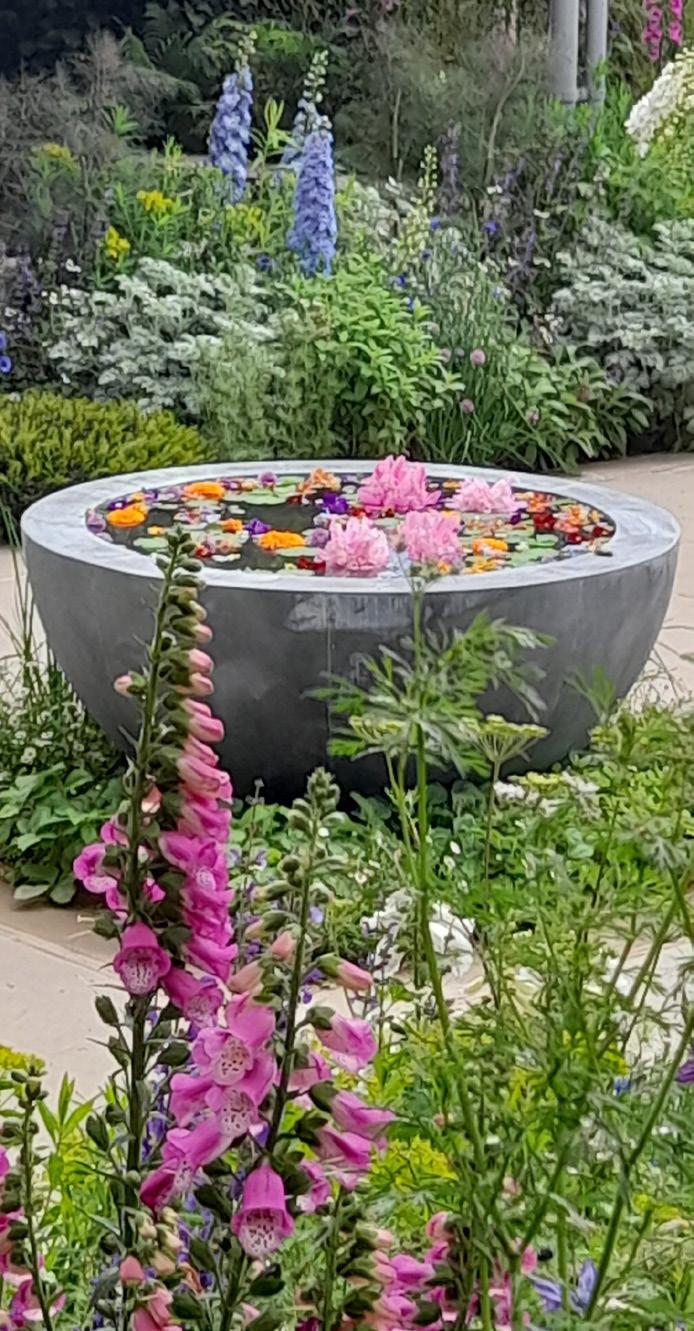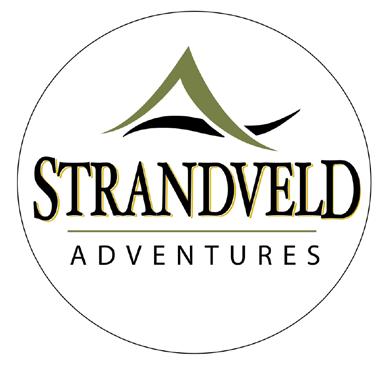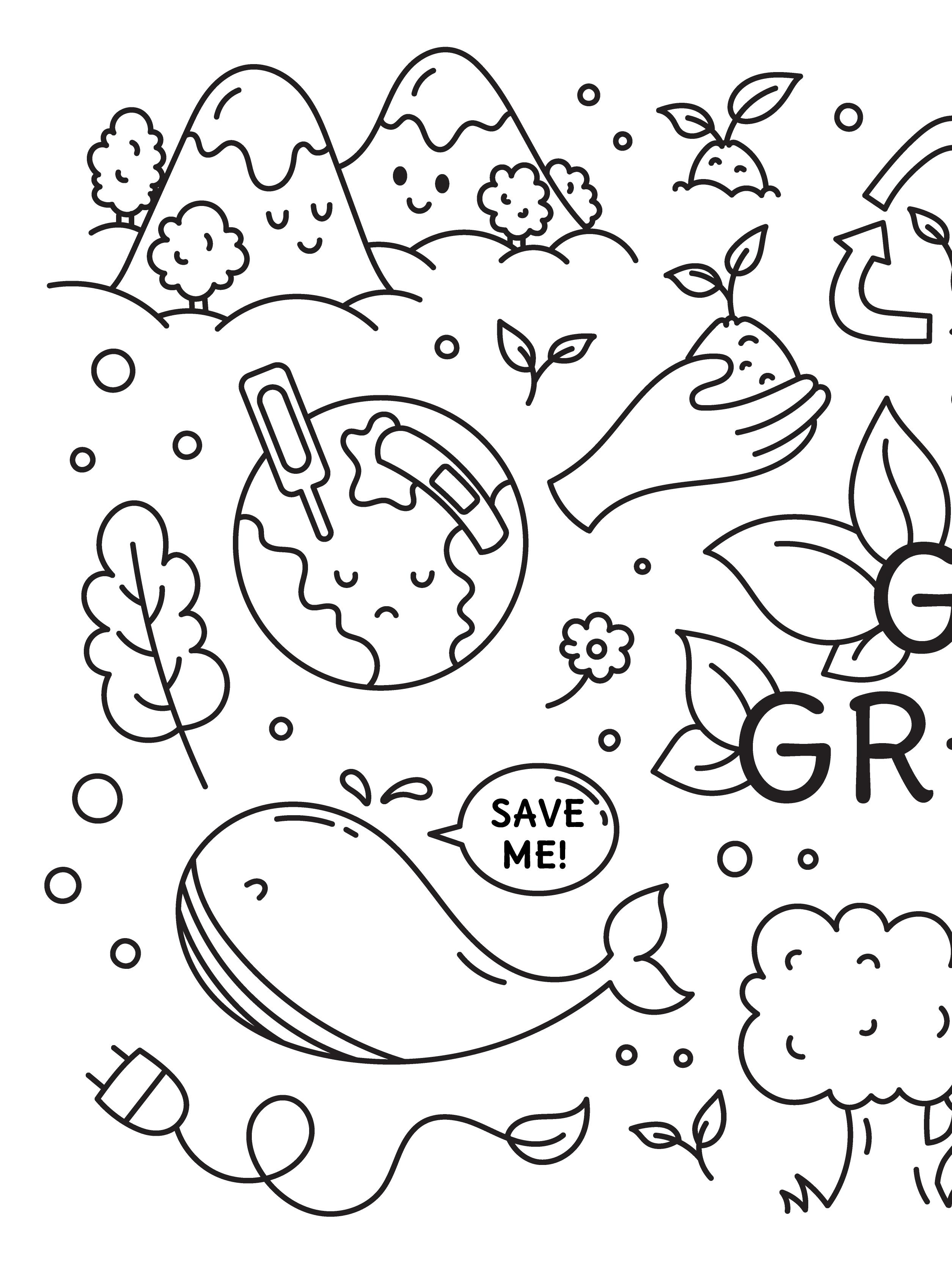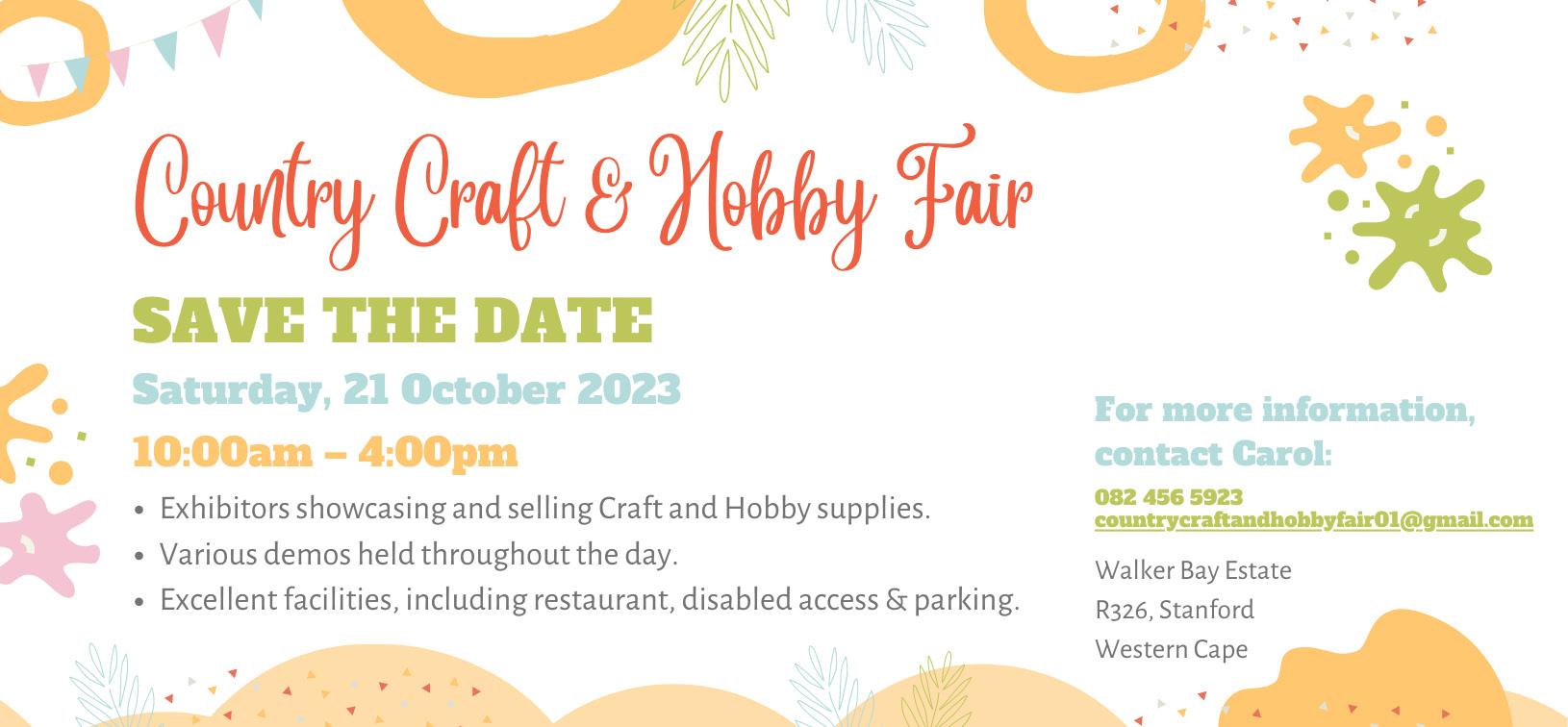READY FOR ADVENTURE?
Introducing Strandveld Adventures (PAGE 6)


EMBRACE HYGGE


Enjoy winter the comfortable, cosy way (PAGE 8)
people, news & what sets us apart

BIZARRE BIRDS

Meet four very strange characters (PAGE 17)

A PUBLICATION FOR STANFORD & SURROUNDS ISSUE 13 JUNE 2023 R25
the STANFORD
Above: The splendid-looking Agapanthus Black Jack bred by De Wet Plant Breeders in SA won ‘Plant of the Year’ at the Chelsea Flower Show in the UK.
Photo: Cape Garden Centre PAGE 5
FROM THE EDITOR’S DESK
SENDING WARM VIBES YOUR WAY
Winter has arrived in full force. Instead of letting the cold, wet weather dampen our spirits, we should rather embrace the short days and long nights with lots of cosy moments spent with our loved ones – enjoying the comfort of home, snuggling under blankets, sitting by the fireplace, and eating hearty meals.
Winter also reminds us of the importance of gratitude and acts of kindness. It's a season for giving back to the community, supporting those in need, and spreading warmth and cheer to others.
You will notice a trending theme… I’ve gone a bit Dutch with this issue in that it’s all about sharing, caring and spreading warmth and cheer to others, and to ourselves. Ineke and Ronald from Union Grocery & Eatery recently hosted a wonderful Dutch-themed dinner where diners got a taste for Dutch cuisine (pg 3) and a feel for the comfort and ambience of Hygge (pg 8). The recipe for the month is ‘Boterkoek’ – a Dutch Butter Cake (pg 9). We have so many wonderful and caring people within our community, from Rotary handing out warm blankets and knitted items to the most vulnerable (pg 7), to SAWS providing animals with much needed care and attention (pg 7), to members volunteering their time to upskill students from our community wanting to learn about and work in Tourism (pg 6), to Stanford Conservation’s ‘Forgotten Ones’ committee for initiating a 67-Minute Cemetery Clean-up Campaign for Nelson Mandela Day coming up on 18 July – and many, many others, as you will see. So, read on and keep thinking those warm thoughts…
MELISSA MC ALPINE
Editor 078 324 5692
melissa@stanfordnewsagency.co.za
MARIKE GROOT
Artwork | Layout | Design design@stanfordnewsagency.co.za



Ad bookings
admin@stanfordnewsagency.co.za
CONTRIBUTORS FOR THIS ISSUE:
Andrew Herriot
Christine Farrington
Christine Stevens
Robynn de Klerk

Lana Coates
www.stanfordnewsagency.co.za
(Coming soon)
CONTACT US Melissa
The Stanford Spectator is proudly brought to you by the Stanford News Agency
The Stanford Spectator is a monthly print and online publication that comes out on the 3rd Friday of every month. Advertisements to reach us by no later than the Friday prior to when the next issue is due. To place an advertisement, please contact: admin@stanfordnewsagency.co.za

SUBSCRIPTIONS
Don’t forget to subscribe! Our online publication is now available at no cost! Print copies are available to purchase at our shop: Shop 1, 14 Queen Victoria Street, Stanford. (Free delivery within Stanford). Contact: admin@stanfordnewsagency.co.za
THANK YOU, CALEDON FM

Disclaimer: Great care has been taken in the preparation of this publication. However, Stanford News Agency cannot accept responsibility for any errors which may inadvertently have occurred. The opinions expressed herein are those of the authors and/or persons interviewed, and do not necessarily reflect the views and values of Stanford News Agency. Any comments, suggestions or complaints may be forwarded to: melissa@stanfordnewsagency.co.za
A note from Christine Farrington
ALL THE WAY FROM ST IVES!
Being in the lovely Cornish and picturesque town of St Ives, Cornwall, I thought it would be nice to share this ancient rhyme with Stanford:
As I was going to St Ives, I met a man with Seven Wives. The seven wives had Seven Sacks. The Seven Sacks had Seven Cats. The Seven Cats had Seven Kits. Kits, Cats, Sacks and Wives.
How many were there going to St Ives?
The first person to give the correct answer to Stanford News Agency 078324 5692 will receive a six-month print subscription of The Stanford Spectator.
2 The Stanford Spectator 23 JUNE 2023
Above: Annie (Caledon FM), Melissa and Piper (Stanford News Agency).
Caledon FM spent a day parked in front of Ou Meul in Stanford on Monday 5 June, meeting and interviewing people from Stanford.
A DUTCH CULTURAL CULINARY EXPERIENCE






at Union
By: Melissa Mc Alpine
On Tuesday 6 June, Union owners Ineke and Ronald hosted a Dutch-themed dinner at their charming establishment in Queen Victoria Street, where guests were treated to hearty and flavoursome Dutch dishes with a twist. Since it was a rather cold evening, the warm fire that greeted us as we entered was both welcomed and appreciated, and provided a warm ambience to the evening.

A number of popular dishes were served throughout the evening, giving guests a taste of the Netherlands. For the appetiser, a firm favourite of the Dutch, bitterballen were served. Basically, bitterballen are deep-fried croquettes consisting of a mixture of meats like chopped or minced beef or chicken,
which are then mixed with beef broth, butter, flour, spices and sometimes vegetables, creating a meaty gravy that’s then coated in crispy breadcrumbs, fried, and enjoyed with mustard. It was only afterwards that we were told by Ronald that what we had eaten, which had the taste and texture of chicken, was in fact a vegan alternative. Very sneaky!
Next up was a creamy and delicious Mustard Soup (mosterdsoep). Potatoes are a staple food in the Netherlands, so it comes as no surprise that the main course consisted of three varieties of stamppot - traditional hutspot (mashed potato mixed with onions and carrots), boerenkool (a kale stamppot with sesame seeds, served with a tamari-onion sauce), and zuurkool (an oven-baked, local sauerkraut and pineapple stamppot). For the meat-eaters, this filling course was served
with a tasty smoked sausage (rookworst). For dessert, guests were treated to stroopwafels (syrup waffles) and ice-cream. The creaminess of the fresh ice-cream went very well with the syrup and cinnamon waffles and was a delightful ending to a wonderful evening. We’re already looking forward to the next one, Ineke and Ronald (nudge, nudge, wink, wink!).
Some Useful Dutch Phrases
Please — Alstublieft
Thank you — Dank u
You’re welcome — Graag gedaan
Enjoy your meal — Eet smakelijk!
It’s tasty! — Het is lekker!
3 The Stanford Spectator 23 JUNE 2023 OUT & ABOUT
Above (clockwise): Ross Howlett and Victoria Menzies, meal accompaniments, mustard soup, diners enjoying the ambience of the evening, and stamppot with smoked sausage.
4 DATES TO DIARISE
UPCOMING EVENTS
JUNE
29 Conservation Think & Drink Quiz Night (6:30 for 7pm)

Birkenhead Brewery Pub
Bookings: Leigh King 083 418 8973
30 Mike Fabricius Live (6pm)
Stanford Kitchen | Open for dinner from 18:00

R80 per person cover charge | Contact: 079 975 6211
JULY
8 Hops @ The Hills Craft & Beer Festival (from 12pm)

Cash sales at stalls | R100 for adults and kids under 18 free
Shuttle service available | Details: 072 603 3521
18 67 Minutes Nelson Mandela Day (9am – 3pm)
Conservation Cemetery Campaign | Tidy up the old cemeteries
Details: Debbie 071 671 5564
21 - 23 Women’s Winter Retreat
Guided meditation, conscious dance, a silent nature walk and a variety of mindful practices
R3 600pp sharing or R3 885 for single occupancy
Riversong in Stanhaven Estate
Details: 066 040 0804 | 081 764 0047
AUGUST
4 - 6 Creation Care Weekend Away
Phillipskop Mountain Reserve
Two nights self-catering accommodation, a presentation on the theology of creation care, an alien hack and hike, etc.
R720pp sharing
Bookings: 073 016 8406 | anna@phillipskop.co.za
5 Merrell Whale of Trail
De Hoop Nature Reserve
The 53km Ultra and the 35km Trail Run with a R100,000 prize money
Details: whaleoftrail.co.za
SEPTEMBER
23 Art on a String (9am – 12pm)
100 drawings by local artists on sale at R100 each
Egret & The Owl Book Café
Details: Marian Binder 083 303 4330
30 10km Hermanus Whale Festival Fun Run (7am – 9pm)
The Old Harbour, Hermanus
Lots of fun to be had and prizes to be won
R200pp | Details: japie@raceday.co.za
OCTOBER
21 Country Craft & Hobby Fair (10am – 4pm)
Large variety of craft and hobby stalls plus demos throughout the day
Birkenhead Brewery (Walker Bay Estate)
Details: Carol Tait 082 456 5923
MARKETS
Market Day @ Martin’s Deli (9am – 4pm)
Fresh produce every Thursday
Martin’s Deli, 1 River Road, Stanford Business Park
Contact: 082 321 0337
Stanford Square Market (9am – 2pm)
Stanford Square, Queen Victoria Street
Details: Nicolene Gericke 083 530 4968
Stanford Saturday Morning Market (9am – 12pm)
The Stanford Hotel Stoep
Details: 082 781 1704 | hotel@stanfordvillage.co.za
WEEKLY EVENTS
Every Monday
Painting Classes with Tracy Algar (10am – 12pm)
Egret & The Owl Book Café
R200 per class | Details: 084 584 3757
Meditation Evenings (6:45pm – 7:45pm)
No charge but donations welcome
Details: Maxine Church-Bingley 082 419 9330
Stanford Striders (4pm)
A 40-minute quick stride along the streets of Stanford
No charge but donations welcome (funds go to the Butterfly Centre)
Details: Andrew Herriot 072 571 7846
Every Tuesday
Decoupage, Gilding, Mosaic Workshop (10am – 12pm)
Ladybird Craft Studio, Stanhaven Estate
Details: Carol Tait 082 456 5923
Calligraphy Workshop (9:30am – 11:30am)
Art studio in Stanhaven Estate
R800 for 4 x 2-hour lessons| Details: Martyn Johnson 084 675 1164 (Other dates and times can be arranged)
Every Wednesday
Painting Classes (10am – 12pm)
Egret & The Owl Book Café
R200 per class
Details: Tracy Algar 084 584 3757
Writing Courses (10am – 12pm)
For anyone requiring assistance with their writing
Lunch and discussion around books and writing
R250 per class, R300 per hour for individual mentorship, R160 for lunch
Egret & The Owl Book Café
Details: Lesley Beake 082 646 4420
Chelsea Flower Show



‘23
By: Christine Stevens
This year the most famous flower show in the world had a very different feel to it. For the last few years, the show has floundered and lost some of its popularity. This year it came back with a bang.
The themes for the show gardens were very much based around sustainability and pollinators. The catchphrase was “Edimentals”- blending edibles in with ornamental plants, which is something I think home gardeners have, on the whole, being doing for many years, but now has a name and professional gardeners showed how beautifully this can be done. Many of the gardens had health and wellbeing as their inspiration. Gone are the formal gardens, there was not a single patch of lawn in sight.
This new loose feel featured garden had flowers such as foxgloves, a huge amount of beautiful iris, tall prairie grasses and beautiful climbing roses. The planting overall was very naturalistic. The wildflowers looked lovely, and many stands featured the importance of weeds as pollinators. A controversial subject, but as so many weeds are edible, I for one
am firmly on their side as long as they do not take over.
Every year a flower of the year is announced, and this year that flower was Agapanthus Black Jack - a cross between two South African varieties creating a dark flower with many beautiful flower heads. Agapanthus are becoming increasingly popular worldwide.
My personal favourite garden that kept drawing me back again and again was “The Nurture Landscapes Garden” by Sarah Price. The garden featured a beautiful mix of irises, tulips, tulbaghia and poppies, all in soft colours planted in a natural space surrounded by straw bale walls, rendered in lime mortar. Some of the plants were in huge, handmade, earth-coloured pots and the overall effect was that of an impressionist painting.
Another very beautiful garden was Mark Gregory’s the Savills Garden. Mark has won over a dozen gold medals at previous shows. This garden featured a magnificent working outdoor kitchen area where chefs prepared lunch daily from plants grown in the garden, which, needless to say, were replaced each night so that the garden always looked per-
fect. The flowers had a pastel palate of whites, pinks and blues which worked beautifully between the rows of green vegetables. A small stream flowed through the garden with water captured from the roof of the kitchen area to feature sustainable irrigation methods, and a huge urn filled with water and cut flowers for the birds and insects to make use of.
The Balance Garden featured a mushroom growing area inside a re-purposed shipping container that was completely transformed to create the smartest mushroom shed anyone has ever seen. This was surrounded by a glade of wildflowers and pollinators featuring the importance of natural landscape pollinators. This was the first year that Mushrooms have made an appearance at the show, and judging by this garden’s popularity, it won’t be the last.
Alongside the large show gardens were smaller sanctuary gardens and balcony gardens which featured ideas and plants suited to the urban environment. Overall, there were so many beautiful ideas that reached a much broader appeal, so it was very easy to leave the show with loads of ideas and information to include in your own garden.
5 The Stanford Spectator 23 JUNE 2023 WHAT’S TRENDING?
Above: The Nurture Landscapes Garden designed by Sarah Price (left), and Mark Gregory’s working kitchen and bird bath in Savills Garden (middle and right). Photos: Supplied
PROJECT ‘IZIKO’
By: Melissa Mc Alpine
Afew months ago, Richard Randall and Casper Bester teamed up to form Strandveld Adventures – an association aimed at providing locals and visitors to Stanford with fun and exciting outdoor activities such as hiking, canoeing, kayaking, zip-lining, quad biking, whale watching and more. Both Richard and Casper have experience in the tourism industry and share a love for the outdoors.


“The reason I started the project is twofold - to give something back to the tourism industry for my 17 years of guiding, and to uplift members of Stanford South by training them as guides in the village,” says Richard.
Both Richard and Casper have a desire to help underprivileged youngsters wanting to get ahead in life. Paying it forward is their way of giving back to the community.
As with anything, initiating such a project takes a certain amount of funding. Richard reached out to the Overstrand Municipality, but when no assistance was forthcoming, he sought and found assistance elsewhere.

The second step was to create a suitable training curriculum so that successful applicants would have a solid foundation from which to grow. Once trained, guides will be able to manage guided nature walks, conduct walking historical tours of the village, do environmental talks, and possibly even run educational workshops. Safety and risk management will form part of their training so as to minimise potential hazards associated with adventure activities. In conjunction with Livingstone Tourism Academy, Richard prepared a training manual.
Step three was inviting interested applicants to apply for the course. After receiving a number of applications, Richard and Casper worked through each one to source the two most suitable candidates. Once this was achieved, the two successful applicants were contacted, leading on to
step four of the project – training, which started at the beginning of May.
According to Richard, training sessions are going very well, and they will be starting on the practical training side of things towards the end of June. The aim is to have the final assessments, first aid and Tour Guide registration completed by the end of October. Once they’ve successfully completed the course, the two guides will be employed by Strandveld Adventures and will conduct guided tours of the village, including the wandelpad, Phillipskop, and surrounding areas.
6 STANFORD TOURISM
Above from left to right: trainees Themba and Alana.
Iziko is an isiXhosa word meaning ‘hearth’. The hearth is traditionally and symbolically the social centre of the home; a place associated with warmth and kinship.
BEATING THE COLD THIS WINTER
 By Lana Coates
By Lana Coates
The winter cold hit earlier this year and with all the rain we’re having there are many people suffering as a result.
Distribution of blankets and warm knitted items to the most vulnerable in our community – the elderly, the sick and children – took place during the last week of May. Following our appeal for funding we were able to purchase enough blankets to get the project off the ground.

Final distribution in Stanford saw around 220 blankets – both purchased and knitted/ crocheted – handed out to the Stanford community. Around the same number of small, knitted items were also distributed. We are currently busy with distributions to the farms and Die Kop.
There was much excitement, especially for the children, when they were allowed to choose their own knitted item once they’d received their blankets. Some knew exactly what they wanted while others were spoiled for choice. Everyone went home happy, though.
The success of this project is due to the assistance we receive from members of our community. Not only were folk exceedingly kind and generous with funds but there is a whole team of ladies out there who knit or crochet blankets, beanies, scarves, gloves, head-warmers throughout the year to fill up our stock boxes. Added to this we were extremely fortunate to receive two parcels of knitted baby jerseys and beanies all the way from Port Elizabeth, not to mention around 60 beanies all the way from Australia!
Finally, thank you to every person who contributed in some way to this project for 2023. You made it the success it was.


CLINIC AT DIE KOP
SAWS held its first Vet Clinic at Die Kop recently. The clinic was a great success and in total, six puppies, two cats and 24 dogs were treated. SAWS would like to thank vet Dr Kruger from Southern Vet in Kleinmond and his assistants Jay, Roland and Cecelia from the Zizemeleni Co-Op as well as all SAWS volunteers and members of Die Kop community who made this clinic and rewarding outreach program possible.



7 The Stanford Spectator 23 JUNE 2023
COMMUNITY
VET
VITAMIN SEA
SHE SEEKS SEASHELLS ON THE SEASHORE…
By: Melissa Mc Alpine
Since moving down to the Western Cape from Johannesburg, one of my favourite things to do, together with my daughter, is to go walking along the beach and clambering over rocks in search of interesting treasures gifted by the sea. The beach is known for its calming and serene environment. The sound of waves, the gentle breeze, and the vastness of the ocean all help to bring about peace and calmness – the perfect antidote for overcoming the stresses of daily life. Beachcombing, it turns out, is a real thing.
When beachcombing, be on the lookout for interesting shells, rocks, sea glass, driftwood, and any other items that catch your eye. It’s a good idea to take a bucket or bag with you to collect your treasures. It’s important to be respectful of the environment. Avoid removing living
organisms such as live shells, plants, or animals, and always leave the beach as you found it.

Once back home, you can learn about the items you find by browsing books or online resources. Understanding the natural history and significance of what you find can enhance your beachcombing experience. Be aware of your surroundings at all times. Watch out for incoming waves and avoid venturing onto dangerous rocks. Also, be careful when handling items that may be sharp or potentially hazardous.
The combination of physical activity, fresh air, and relaxation at the beach can promote a more restful night’s sleep. Beachcombing isn’t only about finding little sea treasures, it’s also about enjoying the beauty of the beach, connecting with nature, and experiencing the peace and serenity of our beautiful shores. Have fun exploring and treasure all your moments spent by the sea.
Hygge is about finding joy in the present moment, fostering connections with loved ones, and prioritising self-care. Whether it's enjoying a cup of hot tea by a crackling fire, snuggling up with a good book on a rainy day, or gathering with friends for a candlelit dinner, hygge celebrates the little moments that bring comfort and happiness.
While the concept of "hygge" originated in Denmark, the Netherlands has its own similar concept called "gezelligheid." Gezelligheid (pronounced "heh-zell-uh-kheid") is a Dutch word that encompasses the feeling of cosiness,
warmth, and pleasantness. It refers to creating a comfortable and inviting atmosphere, often in the company of loved ones or friends.
Gezelligheid is about embracing simple pleasures and creating a sense of togetherness. It can be experienced through cosy gatherings, shared meals, or enjoying a relaxed evening at home with loved ones. Similar to hygge, it emphasises the enjoyment of life's little moments and finding contentment in the present.
In the Netherlands, gezelligheid is deeply embedded in the culture, particularly during colder months when people seek comfort
and cosiness indoors. It can be experienced in cafes, restaurants, or even in Dutch homes, which are often decorated in a cosy and inviting manner.
Incorporating hygge into your daily life can offer you many benefits, enhancing your overall wellbeing, fostering stronger relationships, supporting mental health, cultivating gratitude, and promoting resilience and happiness. It's a gentle reminder to slow down, appreciate the present moment, and create cosy havens of comfort and contentment in your everyday life.

8 The Stanford Spectator 23 JUNE 2023 HEALTH & WELLBEING
EMBRACE THIS WINTER
hygge
(Dutch Butter Cake) Boterkoek
This delicious Dutch boterkoek (butter cake) is moist with an intense almond flavour.

It’s a favourite in most Dutch households!

Ingredients
2 large eggs
2 ½ cups all-purpose flour
2 teaspoons baking powder
1 ½ cups white sugar
1 cup butter, softened
1 tablespoon almond extract
2 tablespoons thinly sliced almonds (optional)
Directions
1. Preheat the oven to 175 degrees C. Grease two 8-inch round cake pans.
2. Whisk eggs in a small bowl; reserve about 1 tablespoon for brushing over dough. Whisk flour and baking powder together in another bowl.
3. Beat sugar and butter in a large bowl with an electric mixer until light and fluffy. Mix in beaten eggs, then stir in almond extract. Stir in flour mixture by hand using a sturdy spoon; dough will be stiff.
4. Press 1/2 of the dough into each prepared pan. Press almond slices into dough, then brush reserved egg over top.
5. Bake in the preheated oven until the top is golden brown, about 30 minutes. Let cool, then cut into wedges to serve.
9 The Stanford Spectator 23 JUNE 2023 RECIPE OF THE MONTH
Prep Time: 20 mins | Cook Time: 30 mins | Total Time: 50 mins | Servings: 16 | Yield: 2 8-inch cakes

10 The Stanford
23 JUNE 2023
Spectator
ACTIVITY PAGE FOR KIDS

11 The Stanford Spectator 23 JUNE 2023
ACTIVITY PAGE FOR KIDS
WORLD ENVIRONMENT DAY
What’s your solution to pollution?

“Protect, Preserve, and Prosper: Go Green!”
This year marks the 50th anniversary of World Environment Day, which was held on 5 June.


The theme for the year is: “#BeatPlasticPollution” and aims to educate people on the importance of cutting down on single use plastics and encouraging recycling initiatives.
Did you know that over 400 million tonnes of plastic is produced every year worldwide? Even more astounding is that half of the plastic produced can only be used once, and of that less than 10 per cent is recycled. Sadly, a large amount of plastic ends up in our rivers and oceans, leading to devastating consequences for our ecosystems.
• Use paper on both sides and make use of scrap paper.
• Pick up and properly dispose of trash and recyclables.
• Organise a community cleanup.
• Start a compost.
• Donate old toys and clothes to others who need them.

• Clean out jam jars and reuse them as drinking glasses.
• Read a book and save electricity.
• Plant a tree.
• Turn lights off when you exit a room.
• Don’t leave the refrigerator door open for too long while deciding what to eat.
What plastic can be recycled?
• Ice-Cream Tubs
• Plastic Milk Bottles
• Plastic Water Bottles
• Cleaning Product Containers
• Clingwrap
• Styrofoam
• Toothpaste Tubes
• Chip Packets
Remember to wash and rinse your plastic before you put it out for recycling.
What does an eco-friendly prisoner ask for? A solar cell.
Freedom for the gummy bears! Away with the plastic bags!

12 The Stanford Spectator 23 JUNE 2023 LETSOLO KIDS
and Environmental
www.lwes.co.za
This page is sponsored by Letsolo Water
Services
Reduce your reliance on single-use plastics
By: Robynn de Klerk
In line with World Oceans Day and World Environment Day this month, I thought I would share a few practical steps we can all take to reduce our reliance on single-use plastics. And I don't just mean recycling because recycling isn't really the solution we think it is. In fact, recycling should be the last resort and only after we have tried the following: -
Reuse plastic in your home:
You probably buy the same cleaning products again and again, right? So, do you really need the same original, branded, plastic-heavy packaging every time? Fortunately, we have the clever Hermanus Eco Project to help us change this one small habit, which can save many bags of plastic waste per household.

Fiona Matthes from Hermanus Eco Project sources the best biodegradable, natural and septic-tank-friendly cleaning products in bulk and then repacks them for us in upcycled and reused plastic or glass containers. After all, your laundry powder or wonder gel gets hidden in a cupboard anyway, so what does it matter if it's in a reused jar or ice-cream tub? It's one easy, but meaningful change we could all make to instantly reduce our monthly plastic use.
Buy more items in bulk, less often:

Before there were supermarkets in every neighbourhood and latenight convenience stores, families would plan their big monthly shopping. This habit saved them money, time and resulted in far less throw-away packaging.
If you're anything like me and dislike the busy, artificial supermarket spaces with their endless rows of commercial products, then consider rather buying your nut butters, oats, lentils and other pantry staples in bigger bulk quantities as part of your once-a-month shop.
I've sourced some wonderful pantry products for our Food Club, including organic and gluten-free options, which you can pop into your virtual trolley when the shop opens for orders. Which, of course, is infinitely more pleasant than fighting with actual big plastic trolleys! Am I right, or am I right?
Reduce excess packaging and waste:
With group buying, the tremendous benefit is that every supplier delivers only once with everyone's combined order, all in one big box. Contrast that with your last Takealot order and multiply all that excess packaging by all the people in Stanford and Hermanus alone who may have ordered something similar.
It may be convenient, but that system of any-time online shopping is exceedingly wasteful and expensive. What makes the Food Club concept so smart is that you still have all the ease of online shopping, but with none of the excess packaging and waste. Fewer delivery miles split over more Food Club members makes it all more affordable, too.
Switch to reusable silicone and smart kitchen solutions:
The Souper Cube is a silicone food storage tray with clever space-saving portion sizes to allow for easy freezing. When ready to use, simply pop out your sauces, soups, stews, hummus or yummy leftovers. And these clever cubes are freezer, oven and dishwasher-friendly!

13 The Stanford Spectator 23 JUNE 2023 ENVIRONMENT
Above, from top to bottom: Choose upcycled carrier bags and glass bottles instead of plastic ones. The Souper Cube (a silicone food storage tray) containers. Eco-friendly cleaning products in glass bottles.
STARS ARE BORN
Aron Gcotyelwa, the Stanford Housing Officer for the Overstrand Municipality whom I’d befriended when building my house “Waterford” is on the dance floor next to my five-year-old great nephew Adam Crowther, showing him the actions of the latest dance moves. Adam is good, really good, and so of course is Aron. Watching the two of them is mesmerising. Totally in sync together, rhythm and style. Everyone stops to watch open-mouthed. Proud Grandma Brenda Crowther tells everyone in earshot that she taught Adam to dance when he was three, now Aron Gcotyelwa is taking him a step further.
A few years later, Adam joined a dance group in Fish Hoek that eventually culminated in him dancing in performances at CAPAB (Cape Performing Arts Board). His voice, too, led him to join the singing group “The Crooners” and later to the Cape Town Male Voice Choir where he sang in St Georges Cathedral. His family were convinced that he would become an entertainer. Adam had other ideas as university beckoned. He wanted to study Electrochemistry, Physical Chemistry and Computer Programming - a far cry from the stage. The first month into his first university term saw him join the choir and he was immediately snapped up to perform and sing as the lead role of Joseph in the university’s production of “Joseph and the Amazing Technicolour Dreamcoat.”
 By: Christine Farrington
By: Christine Farrington
At a 40th Birthday Party held in Stanford on 6 February 2009, some 80 odd people gathered inside and out enjoying the occasion. My great niece, Olivia, sang a beautiful piece accompanied by Judy Gardiner on the piano and speeches followed. Then, as food and drinks were being served, the mother of all thunderstorms descended upon us – rain, thunder and one of the best displays of lightning I have ever seen, lit up the entire garden and the mountains around us. It was spectacular! But the rain eventually drove the guests inside the house where the men decided to lift or push all the furniture aside to make room for a dance floor. And there the story began.
Aron Gcotyelwa was becoming another rising star. He was promoted from Stanford to Gansbaai in April 2020. He took it upon himself to study at Stellenbosch University where he gained an Honours Degree in Public Administration and Management. Aron was then encouraged to apply for a much higher position in Hermanus, which was successful. He is now the Senior Manager of Corporate Projects for all of the Overstrand Municipality from Rooi-Els to Pearly Beach and beyond. This is a remarkable achievement from a good Stanford lad who, from 15 September 2003 to 28th February 2010, was an income clerk at Stanford Municipality. Today, Aron is happily married with two children and still lives in Stanford.

Two remarkable young men at a party, one five years old, one twenty-eight years old, on the floor in 2009 giving an entertaining show of fabulous dancing, fun, laughter, and camaraderie. Both Adam and Aron are stars in their own right. In August this year, they will be re-united for the first time since that night back in 2009, when there will be lots to talk about and, who knows, maybe even another dance performance.
WELCOME TO YOUR FOREVER HOME,
By: Melissa Mc Alpine
Panthera Africa Big Cat Sanctuary (PABCS), with the assistance of Animal Survival International (ASI), recently relocated an exquisite 13-year-old leopard named Gabriel from a facility in Gauteng to his new home at Panthera in Stanford.

Up until his relocation, Gabriel was just one of the countless captive big cats in South Africa kept in unsuitable, confined enclosures. Cruelly taken from their mothers at a young age, these wild cats are exploited for financial gain.
Panthera Africa is home to around 30 wild cats including tigers, lions, leopards, cheetahs, caracals, and servals. Every animal at Panthera is either emotionally, physically, or genetically impaired, and as such cannot be released into the wild.


At Panthera, these gorgeous beasts are given the space and freedom to explore, play and just be cats. One only has to visit the sanctuary to see how well the animals are cared for in large, customised enclosures. Panthera does not allow any hands-on interaction, breeding, nor trade of any kind.
While he was a bit hesitant when he first arrived at Panthera, Gabriel has since adapted very well to his new surroundings and made himself at home, much to the delight of the Panthera team.
14 The Stanford Spectator 23 JUNE 2023 A FEEL-GOOD STORY
Gabriel!
Left to right: Adam Crowther & Aron Gcotyelwa.
Above: Panthera’s newest resident, Gabriel.
COUNTRY CRAFT & HOBBY FAIR 21 OCTOBER 2023

(10AM – 4PM)
Craft and hobby fairs provide an ideal platform for artists and artisans to exhibit their unique talents and creations. Carol Tait, owner of Ladybird Crafts in Stanford, recognized a need for craft and hobbyists alike to be given their own platform to showcase and sell their handcrafted items at an annual craft and hobby event. And so, the idea of the Country Craft and Hobby Fair was born.
Planning and organising the event is already underway; the fair will be held at the Walker Bay Estate on 21 October 2023 from 10am until 4pm. The event will be a fun, family-oriented day where even young crafters are encouraged to participate.

“I believe that encouraging and supporting young entrepreneurs is essential not only for their own per-
sonal growth but also for the vibrancy and evolution of the craft industry as a whole,” said Carol. Various demonstrations will be held throughout the day giving people a chance to learn about the various crafts and to try their hand at some of them. There’ll also be live entertainment and the Birkenhead Brewery restaurant will be open for light meals and beverages.
For further information, or to book your stand, please contact:
Carol Tait 082 456 5923 countrycraftandhobbyfair01@gmail.com
Bead Art
Calligraphy
Candle Making
Card Making
Decoupage
Doll Making
Dot Art
Embroidery
Flower Pressing
Hat Making
Jewelry Making
Knife Making
Laser Cutting
Leather Work
Macramé
Model Boats, Cars & Planes
Mosaic
Origami
Papier Maché Crafts
Paper Quilling
Pewter
Pottery
Recycled Art
Resin Art
Rubber Stamping
Shell Art
Soap Making
Stained Glass
Stencils
Teddy Bear Making
Tie Dye
Weaving
Wire Work
Woodwork & Carving
Wool, Yarn & Needle Crafts
15 The Stanford Spectator 23 JUNE 2023
PROMOTIONAL ARTICLE
For the of Stanford’s dogs! love
Dogs are known as "man's best friend" for good reason - they bring joy, companionship, and unconditional love into our lives. And if there’s one thing that just about every Stanfordian has in common, it’s the love they have for their dog/s!
It’s for this reason, we’re introducing a new monthly feature called: “For the Love of Stanford’s Dogs!” This is your chance to show off your pooch so we can get to know all the wonderful woofies from our ‘hood.
Send us some details about your furry friend and don’t forget to include a picture pawfect portrait photo. The doggo featured will win a special doggy bag!

Chrissie Curnow who lives along Moore Street in Stanford is the beloved guardian of two special rescues, Becky (top) and Orbit (bottom).
NAME, BREED & AGE: Becky (Africanus, Age 9) & Orbit (A One-Eyed Fox Terrier Mix, Age 12)

PERSONALITY: Becky is quiet and loving but can be quite needy – she has a tendency to put her paw up to let you know she wants to be petted. Orbit doesn’t play so much anymore as she’s getting on a bit.
FAVOURITE TREAT: Both Becky and Orbit absolutely love Rollies treats!
FAVOURITE THING TO DO/GAME TO PLAY: Both Becky and Orbit love going for walks around the village, even though Orbit gets tired more quickly due to her age. Orbit loves to snuggle under the blankets at night and she has her own blanket that she gets under to keep warm and snug.
FAVOURITE PLACE(S) TO GO: Moving to the Cape from the Lowveld was a big adjustment for Becky and Orbit as they’d never been to the sea before. While they didn’t like going to the beach too much at first, they soon got used to it and now love being taken down to Grotto Beach for a run.
ANY BAD HABITS: Both girls are absolute darlings and don’t really have any bad habits. However, Becky’s neediness can become a bit much at times.

16 The Stanford Spectator
BEST FRIEND
MAN’S
Bizarre Birds
By: Melissa Mc Alpine
It was the latest copy of SA Bird Life magazine that caught my eye. Right there, on the front cover, was the strangest looking bird I’d ever seen. It looked like it hailed from prehistoric times and is called a shoebill stork. This led me to search online for further information on this and other weird and wonderful, prehistoric-looking birds found across the globe. Here’s what I found…
Cassowary (aka ‘Murderbird’)

An odd-looking bird that looks like it’s from the dinosaur era is the Cassowary. Considered one of the world’s most dangerous birds, Cassowaries are found in Northern Australia, New Guinea, and surrounding islands. They have a striking appearance with a bony horn on their heads, vibrant colours on their skin and feathers, and long, powerful legs with sharp claws. The largest cassowaries can stand as high as six feet tall and weigh up to 45kgs. While they can’t fly, they swim well and move quickly on land. After the female lays her eggs, she leaves the male to tend to them. The male is responsible for incubating the eggs, protecting the nest, and raising the chicks. Surprisingly, for such scary looking creatures, their diet consists mainly of fruit, insects, snails, and the occasional dead animal. Charming.
Hoatzin (aka ‘Stinkbird’)
Another weird bird of note is the hoatzin, or ‘stinkbird’ as it’s also known as due to its rather stinky smell. It too has a prehistoric look about it with a spiky, punk-like crest on its head, bright blue facial skin, and a long, bulky body covered in brown feathers. The hoatzin feeds only on plant vegetation that ferments in its gut which is what creates the bird’s unpleasant odour. They are known for their unusual behavior, including moving around tree branches using their claws. Hoatzins build large, untidy nests made of sticks and vegetation,

usually near bodies of water. These nests can be communal, with multiple breeding pairs sharing the same tree. The hoatzin is found in certain parts of South America, including the Amazon Basin and the Orinoco Basin.
Shoebill Stork (aka ‘Jaws’)

This oddball of a carnivorous bird has a foot-long beak that resembles a Dutch clog. Its ultra strong jaw muscles and hardened bill help it to easily dismember captured prey. It is characterized by its large, shoe-shaped bill, which is one of the most prominent bills among all bird species. Its eyes are a piercing yellow colour, and its feathers are a blend of grey, black, and white, giving it a prehistoric look. While it feeds mainly on fish, it also eats amphibians, reptiles and sometimes even small birds. It can reach between 3.5 to five feet in height and has a wingspan of over eight feet long. They have long, thin legs with large feet ideal for walking on the vegetation in the freshwater marshes and swamps they inhabit in East Africa, from Ethiopia and South Sudan to Zambia.
Tawny Frogmouth (aka ‘Camo King’)
A master of camouflage that can hide in plain sight, this bizarre little bird looks like an owl and buzzes like a bee when startled. The Tawny Frogmouth hunt for food at night using the ‘sit and wait’ technique, as in they simply sit, mouth open, and wait for an insect to fly right in. If that’s not the height of laziness, then I don’t know what is. They’re found across Australia and in Tasmania and prefer living in open woodland and parks. Their diet consists mainly of insects, including moths, beetles, and other nocturnal prey. However, being opportunistic feeders, pretty much whatever’s on the evening’s menu is good enough to eat. When threatened, they adopt a freeze posture, stretching out their bodies and closing their eyes to resemble a broken branch or tree stump.

17 The Stanford Spectator 23 JUNE 2023 BIRDING
Above, left to right: Cassowary, Hoatzin, Shoebill Stork, Tawny Frogmouth.
BARRY JONES: THANK YOU FOR THE MEMORIES
By: Christine Farrington


Imet Barry and Adrienne Jones when they were living and managing Reiersvlei, the beautiful, thatched house on the river off the Wortelgat Road in Stanford.
It was fun and laughter at first sight and has remained so ever since. Putting a high point on our friendship was a dinner party at Kobus’s house on the corner of Church Street – a fancy dress party no less! It was winter and around a blazing fire we laughed and laughed until it became another day – my goodness those really were the days!


Sadly, our beloved Adrienne died in 2021 and Barry was left bereft. He refused to move out of their home, The Old Mill House. Together with his son, Simon, he lovingly restored the Old Mill itself at the bottom of their garden. It was a mission of love and hard work for the Joneses, and Barry felt at home in Caledon Street, Stanford. So, together with his three dogs, he adamantly remained.
Barry was never the same after Adrienne’s passing. I spent as much time with him as possible. We occasionally went out for lunch together – Stanford Valley Manor House was one of his favourites. On occasions he would drive me to Hermanus in his high-speed way to collect my car from the garage, with me praying throughout the journey that we would get there (phew!). Barry certainly lived on the edge.
Barry loved his family very dearly – he was hugely proud of his children and his grandchildren. One of our many outings together was to watch his grandson, Henry (a fast spin bowler), play cricket at Hermanus High School.
I feel very privileged to be an honorary member of the Jones family and I know what the loss of Barry will mean to them. My sincere condolences to Simon, Milly, Gill, Charly, Henry, Alistair, and Olivia. I loved your dad more than I could ever say. RIP my dear friend. Love, Chrissy.


RIP dear Allan – the gentle dog-walker. I will miss seeing your sweet smile and cheery wave every day. Love Christine
RIP dear Meyer – the Music man. I still have your messages and favourite songs on my phone. I will listen often and think of you. Love Christine
Top left to right: Barry enjoying his birthday in January this year at his favourite restaurant, the Stanford Valley Manor House, with good friends, Dixie (pictured) and Christine.
Bottom left to right: In remembering and paying tribute to Barry, Christine spent some time at St Ia’s Church in St Ives, Cornwall. Three candles symbolising the three friends she lost within days of one another (Barry Jones, Alan Scheepers and Meyer Terblanche).


18 The Stanford Spectator 23 JUNE 2023 IN MEMORIUM
THE HILLS ARE STILL ALIVE
Julie has had a lifetime of experiences that can be brought to bear rhythmically with a true representation of life with musicals such as Mary Poppins, The Princess Diaries, Cinderella, and many, many more.
It was fitting that Julie’s final public encore, as her career as a soprano singer was ending, could be replaced by a self-spoken, fun-filled, and hilarious lyric of her most favourite song reaching out to those of us who have fun-filled memories of our own as the years close in:
When the dog bites
When the bee stings
When I'm feeling sad
I simply remember my favourite things
And then I don't feel so bad
Well said, Julie. We ageing fans agree:
Cadillacs and cataracts, hearing aids and glasses
Polydent and Fixodent and false teeth in glasses
Pacemakers, golf carts and porches with swings
These are a few of my favourite things
By: Andrew Herriot
Those of you who are retired, over 30/40/50 or thereabouts, will remember (in 1965) the movie: “The Sound of Music” starring that wonderful 4-Octave soprano, Julie Andrews, who, with Christopher Plummer, captured Movie Buff’s attention with the TODD-AO COLOR DE LUXE screen version of one of the most memorable tuneful movie entertainment evenings at the local cinema, or should I say, as a foreigner, the bioscope.

Oscar Hammerstein II produced a most iconic musical statement for Richard Rogers to set to music as a holiday classic and for Julie to sing to the von Trapp children, who were frightened and ran to her room during a thunderstorm to be comforted with her clear soprano voice:
Raindrops on roses and whiskers on kittens
Bright copper kettles and warm woollen mittens
Brown paper packages tied up with strings
These are a few of my favourite things
Words such as those agreeable thoughts for young, frightened children can only lead to images such as:
Girls in white dresses with blue satin sashes
Snowflakes that stay on my nose and eyelashes
Silver-white winters that melt into springs
These are a few of my favourite things
Julie is now 87yrs not 30yrs and she has had a rethink about not what soothing images she can bring to bear with song, but what timely thoughts and portrayals represent today’s world after 55yrs of living. Of course, she thought, I have lived and remember:

Botox and nose drops and needles for knitting, Walkers and handrails and new dental fittings, Bundles of magazines tied up in string,
These are a few of my favourite things
19 The Stanford Spectator 23 JUNE 2023 LAST WORD































 By Lana Coates
By Lana Coates




















 By: Christine Farrington
By: Christine Farrington























